Fashion is more than clothes or accessories – it’s a statement, a reflection of identity. It’s also a mirror of society where trends aren’t just moments in time but windows to the cultural zeitgeist. In 2025, fashion is signaling a shift: the power of style isn’t defined by oversized logos or high-end streetwear. After years of relaxed silhouettes, pandemic-era comfort and streetwear dominance, structured elegance is back.
From Saint Laurent’s suiting to Balenciaga’s accentuated shoulders, 2025 is all about the reinvention of tailoring. The theme takes center stage at the 2025 Met Gala as well – fashion’s own Oscars – where “Superfine: Tailoring Black Style” will celebrate the art of cut material.
But, why now? How will brands weave this revival into their DNA? And in today’s fast-paced world, how can tailoring be both innovative and wearable?
Why Tailoring? The Cultural and Economic Shift Behind the Trend
The pandemic has been over for a long time but its effect on our daily fashion has lingered much longer. Lockdowns blurred the lines between work and home, brought an era of remote everything – work, socializing, college, even parties. Suddenly, dressing meant extremes: sweatpants all day, ties with shorts, loungewear meetings. When Gen Z graduated during lockdown and entered the workforce, many had no idea what to wear to the office. For a moment, the 9-to-5 wardrobe seemed obsolete – a concept almost unthinkable for earlier generations.
Then the pushback came. Sustainability and the demand for quality over quantity – buy less, but buy better – collided with the rise of the “old money” aesthetic. Suddenly dressing sharply wasn’t just about formality; it was a statement. The trend took over the streets and social media, rebranded as “office siren,” “corpcore,” and “boss babe” – a librarian-chic, high-polish take on power dressing.
But tailoring’s return isn’t just about looks. It’s a reaction – an antidote to pandemic-era comfort and a reclaiming of control. It’s also a revival of the ‘70s and ‘80s when suits weren’t just sharp – they were power symbols. In a booming pre-recession economy, women breaking into the corporate world dressed the part, commanding attention in structured, authoritative silhouettes. Designers like Yves Saint Laurent and Giorgio Armani created suits that were armor – broad shoulders, double-breasted tailoring and an imposing stance. Power suits weren’t just about looking strong – it was about owning space.
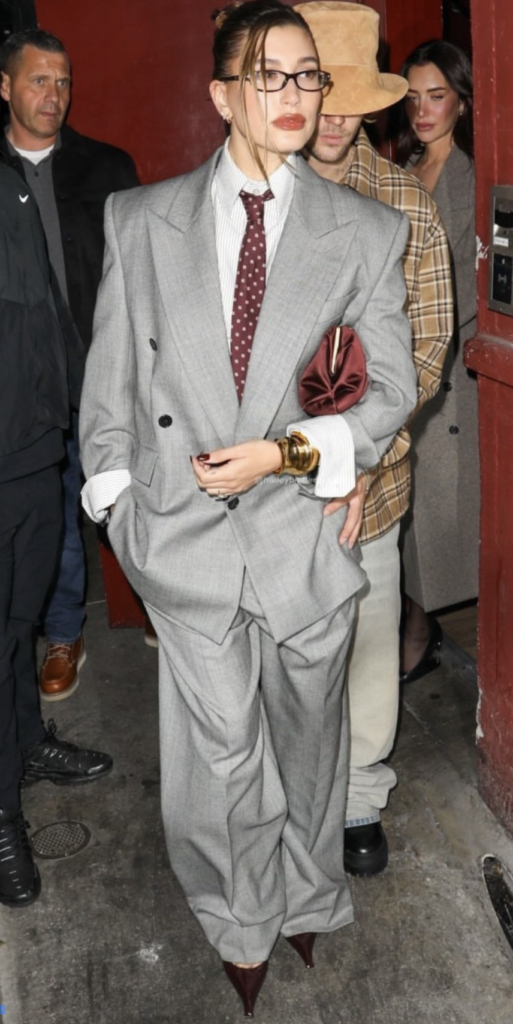
Today, the same holds true. Take Hailey Bieber for example. Shortly after giving birth to her son with Justin Bieber she stepped out for her brand Rhode’s launch in a double-breasted and broad shoulders Saint Laurent suit designed by Anthony Vaccarello. Her wide-leg trousers were grounded by spazzolato pumps. This wasn’t just another suit; it was modern and powerful statement of a new mom and a boss babe.
How Designers Are Redefining Tailoring for 2025
Hailey Bieber’s suit was just one of the many looks that showcased the tailoring revival. At the Dune: Part Two event, Zendaya made a statement in a Roksanda blazer with excess shoulders. In Paris, between shows, Kendall Jenner wore a modern, relaxed-fit The Row power suit.
Even Ariana Grande, who’s known for her princess look, went for the trend and swapped her Wicked gowns for a sharp, double-breasted Saint Laurent tuxedo jacket and trousers at a screening. Grande wasn’t the only one who chose Saint Laurent, Bella Hadid returned to the runway in a SL suit and Nicole Kidman in an oversized version at the Critics Choice Awards. Elle Fanning wore a streamlined Valentino look at the DGA Awards and Victoria Beckham wore a tailored gray suit from her own collection’s pre–Spring/Summer 2025 for the unveiling of 21:50 Rêverie, her new fragrance.
At the 2025 Golden Globes, Ayo Edebiri channelled Julia Roberts in a Loewe power suit and Blake Lively looked stunning in a white, wide-legged Stella McCartney suit for the press tour her movie It Ends With Us.
And last but not least, Selena Gomez and Benny Blanco made their cover debut as a duo for Interview Magazine’s March 2025 issue, announced on Valentine’s Day. The pair posed in matching Loewe pinstripe suits, marking their first-ever joint interview.
The brands behind these suit looks have not just brought tailoring back—they’ve reinvented it. For SS 2025 and Resort 2025 collections, designers are deconstructing, reimagining, and celebrating the suit in ways that feel timeless and modern.
• At Saint Laurent, Anthony Vaccarello channeled his inner Yves and sent out suits in anthracite, black, and plum. These double-breasted jackets and wide-legged trousers had a masculine edge but with softness. This was a collection about control and power, not just a tuxedo worn with nothing underneath; it was about being fully dressed, with shirts and ties. But not all the tailoring was strict. Vaccarello also offered softer options like pajama-inspired ensembles and flowing, jewelled dresses, nodding to Loulou de la Falaise.
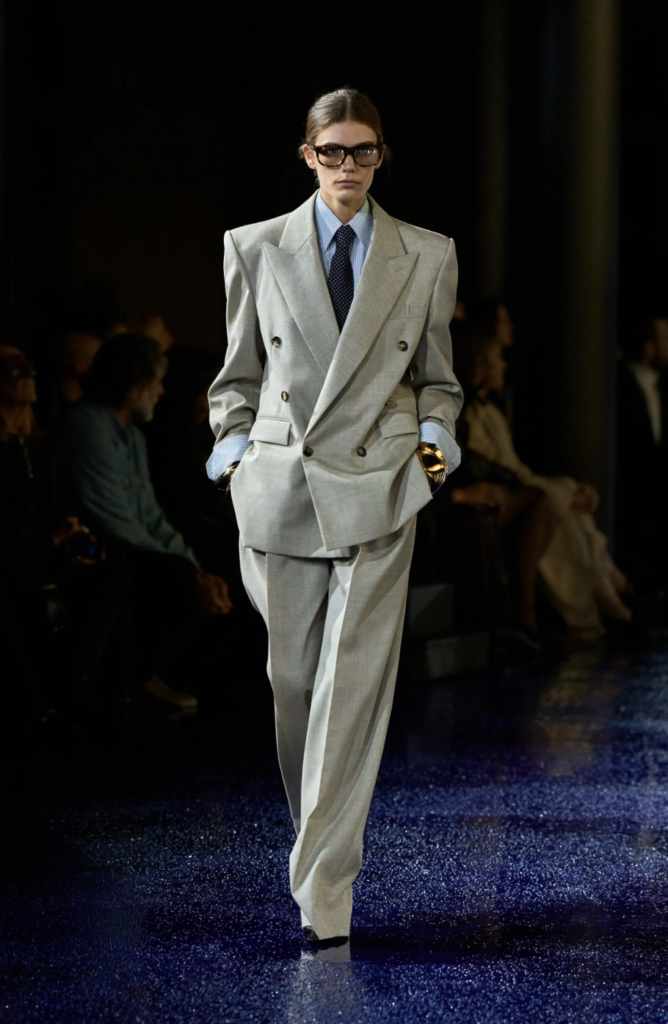
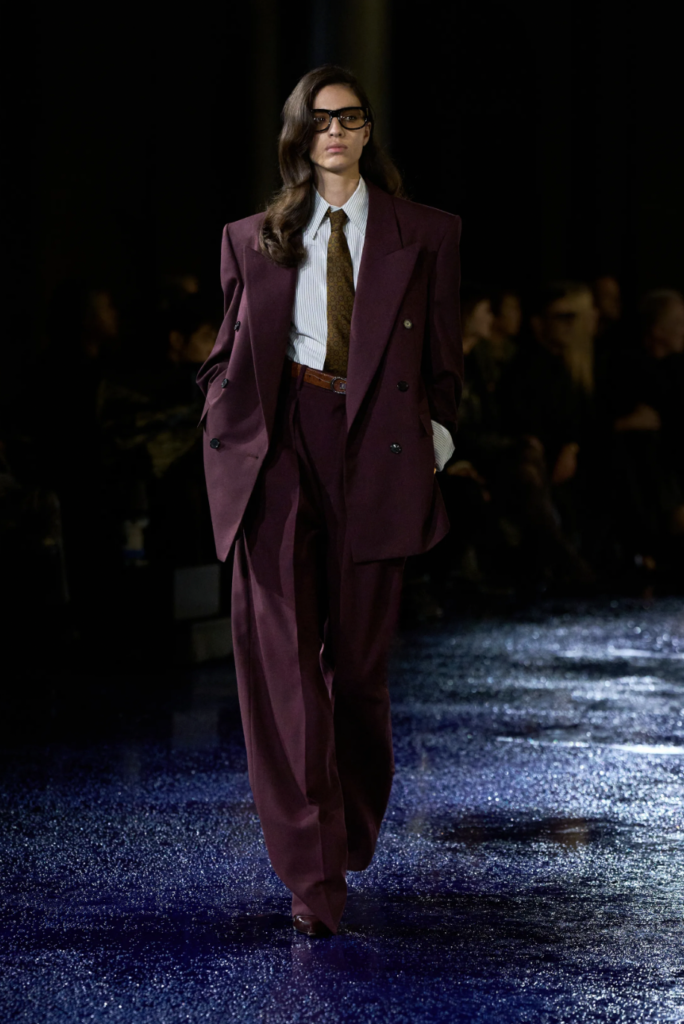
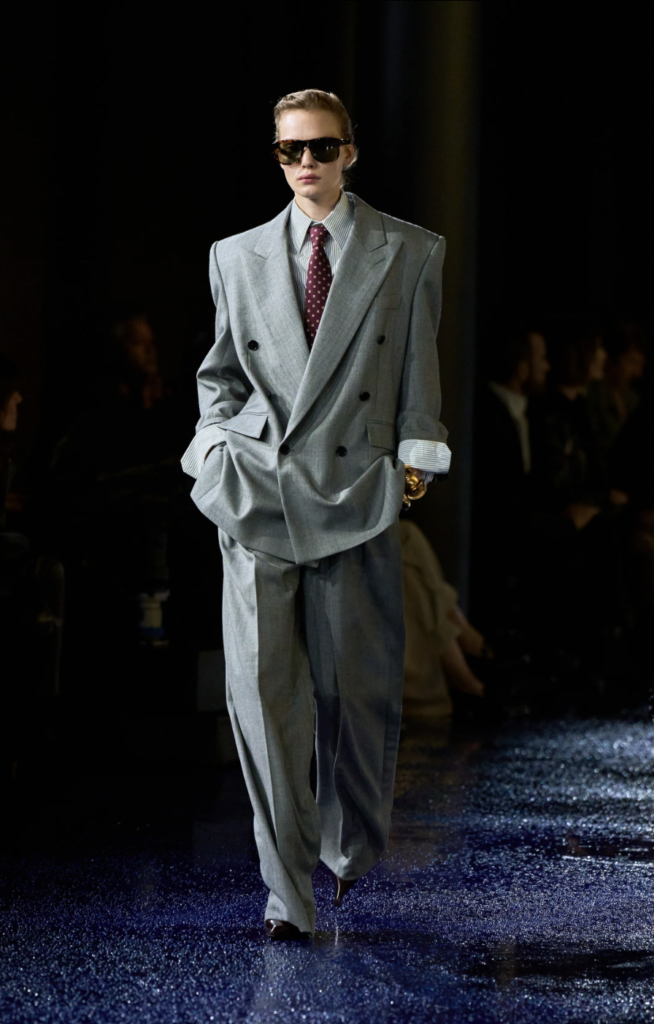
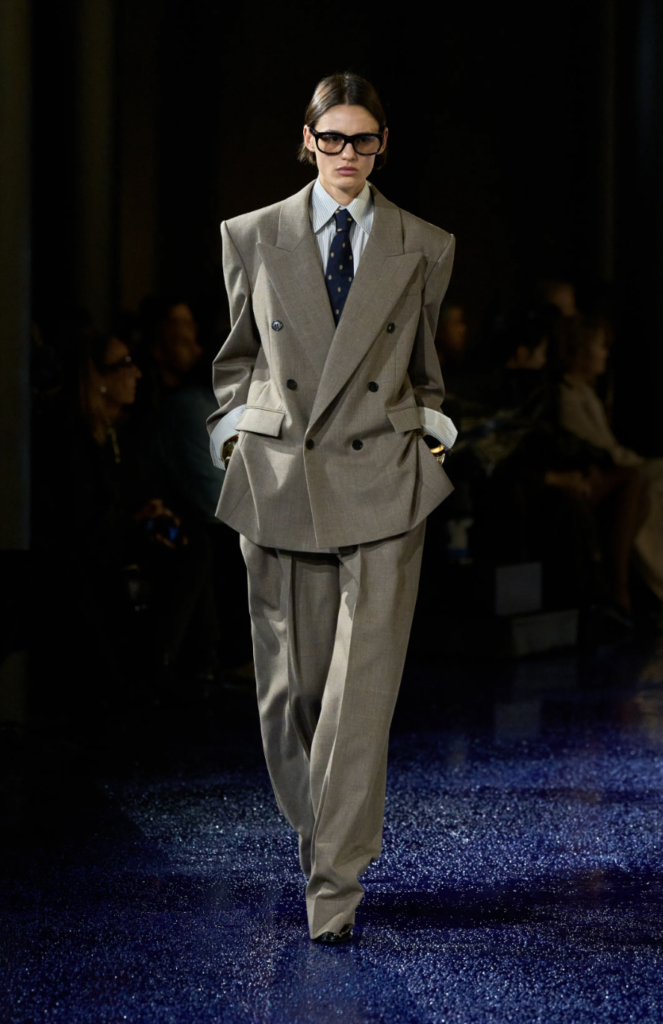
• Amiri took us on a trip back to ‘70s LA and showed us how to wear suits with ease. Draped jackets, wide kipper ties and embroidered bombers in vintage colors and shapes recalled the glamorous hangouts of the era.
• Bottega Veneta under Matthieu Blazy was all about childlike wonder, with tailoring at the heart. Oversized suits in grey and red looked like a child playing dress up. Blazy’s experimental approach to size and construction was evident in surreal edits like trousers with mismatched hems and a jumpsuit with a wrap skirt and a pant leg.
• Stella McCartney went big on volumes and shoulders with her maxi double-breasted jacket suit. Jonathan Anderson for Loewe delved into the brand’s 19th century roots and proposed untypical proportions like narrow-shouldered jackets with wide soft trousers. Even the pinstripe suit, the ultimate symbol of masculine power, has been reimagined.
• Short jacket and skirt suits at Ferragamo and Grace Ling are a youthful and sporty alternative to the classic suit for warmer weather. And for a touch of rebellious romance, Coperni presented “torn” and asymmetrical versions of classic tailoring, suggesting a darker, fairytale-inspired mood.
• Balenciaga’s Shanghai takeover was all about Demna’s signature mix of high and low, with strong-shouldered suits, lace-trimmed dresses and slashed denim all adhering to some unspoken dress code.
• At The Row, tailoring was smooth and fluid, clean-lined and practical. Peter Do’s collection was all about fluid deconstruction and layered looks, with tailored pieces alongside more casual.
Innovation is also shaping the future and the theme of tailoring. The Met’s spring 2025 exhibition, “Superfine: Tailoring Black Style” and the corresponding Met Gala theme, “Tailored for You” will be all about the art of suiting. Beyond traditional craftsmanship, we’ll witness how designers will merge technology with classic tailoring and push the boundaries of fit and form which is already happening. Brands like Son of a Tailor are changing the made-to-order game with AI powered fit technology while SUITABLEE is using AI to create perfect suits.
Tailoring Confidence: Fashion as Empowerment
The 2025 tailoring revival is not just a trend, it’s a self love and confidence movement.
From the red carpet to the runway, designers are reimagining classic silhouettes, blending power dressing with modernity and technology. This is a quality over quantity movement, a reclaiming of control in a post pandemic world and an appreciation for the art of bespoke craftsmanship.
Whether it’s the bold shoulders of Saint Laurent, the deconstructed fluidity of Peter Do or the AI powered precision of new brands, tailoring is being democratized and diversified. As the 2025 Met Gala’s Tailored for You theme says, the future of fashion is in the personal, empowering potential of a well cut garment.
“I have always believed that fashion was not only to make women more beautiful but also to reassure them, to give them confidence”. Yves Saint Laurent